
Modern ideas about life seem to be centred upon reproduction. It seems to be felt that the principal characteristic of living things is that they reproduce and multiply. Indeed, it is very often suggested that this is their purpose, and that it is in some profound sense the intention of every living thing to leave as many offspring in future generations as possible.
It's a way of seeing which is in part shaped by the much deeper understanding of the genetics of sexual reproduction that came with the discovery of DNA. It is also a way of seeing that is in part shaped by a Freudianism and Darwinism in which sex played a central part.
But in Idle Theory living things are seen primarily as capturing and consuming energy. Life is seen as a self-feeding fire. In this vision of life, reproduction is regarded as rather secondary. It's a by-product of life maintaining itself.
In Idle Theory, living things are primarily just trying to stay alive, not to reproduce and pass down their genes to future generations. Or rather, life isn't trying to do anything at all. A self-maintaining life process is something that either manages to keep going and stay alive, or which doesn't. Life is something that passes on the flame of life. And all living things that are alive today are sparks from an original fire which started burning hundreds of millions of years ago.
In Idle Theory, there's nothing particularly remarkable about life. Wherever heat-generating combustion processes are possible, life is possible. And in fact, life is almost inevitable. For in Idle Theory, a forest fire is regarded as a form of life, albeit a very primitive one. In Idle Theory, life is something that started off as something like a forest fire, and which has carried on burning ever since, but has gradually evolved over time to burn more and more efficiently, so that now in the cells of living organisms fires that once burned at hundreds or thousands of degrees Centigrade now burn at about 37 degrees Centigrade.
This is a vision of life in which things like DNA and sexual reproduction are relatively late arrivals. DNA and sexual reproduction just offered the ever-burning fire efficient new ways of staying alight. Life was forever trying out new ways to keep burning, switching from one fuel to another, and reconstructing itself using varieties of instruction sets.
Life
Living things are made up of tiny cells, which grow and divide to produce new daughter cells. Each of these cells is an autonomous living thing. And these living things are tiny internal combustion engines, that are doing exactly the same thing as a motor car engine - which is to burn fuel to produce heat that performs work. While a car engine burns gasoline, a cell is something that burns sugars by combining them with oxygen to produce carbon dioxide, water, and heat. This heat drives the motors of all the cell's various production and maintenance activities, just like a car engine drives fans and pumps and electric generator and an air conditioning system and all sorts of other things. Part of a cell's activity entails capturing sugars and oxygen from the environment around it - something that cars don't do (yet). So a cell is something that consumes energy, but also captures energy.
A single celled organism might be compared to a tiny automobile which goes round looking for gasoline to pump into its gas tank.
Exactly how a cell burns sugars to release heat is rather complicated, and it doesn't entail any flames. Exactly how a cell repairs itself is also very complicated. Exactly how a cell divides to produce a couple of daughter cells is also complicated. But essentially, however cells do all these things, and whatever energy sources and materials they employ, a cell is fundamentally something that uses energy to acquire energy. And this is what all living things do, one way or other. They may use a variety of energy sources, and a variety of different chemical processes, and they may look as different from each other as bacteria, or barnacles, or beech trees, but they're all doing the same thing.
The principal feature of life is not that it grows and reproduces, but that it captures and consumes energy. We pronounce living things to be dead when they stop capturing and consuming energy, stop repairing themselves, and become lumps of inert matter which gradually disintegrate because they're no longer being repaired. We declare someone to have died when they've stopped breathing (and so have stopped capturing oxygen from the atmosphere), when their hearts have stopped beating (and so ceased to transport sugars and oxygen to their component cells), and when they've become cold (because they're no longer burning sugars in their cellular internal combustion engines) and motionless (because their muscles no longer have any power to drive them), and they are rotting and falling apart (because they are no longer repairing and replacing their component cells).
Living things also do other things. They grow. They reproduce. They age. Cells can live either as single-celled bacteria, or as collections of cells in multicellular organisms with specialised component organs like bones and muscles and lungs and hearts. All terrestrial froms of life have DNA templates that code for various the proteins that go to make up the cell structures. These proteins may be structural components, but they also may perform any number of other functions. These protein components of cells can, like so much furniture, be chopped up and burned to keep the internal combustion process going if the usual sugars run short.
Oil Lamp Life
In Idle Theory, living things are seen as self-feeding fires. Little interest is taken in exactly what fuel is being burned, or the exact combustion pathways that are followed, or exactly how they repair themselves or capture energy from the environment around them. Idle Theory is just concerned with the overall picture of what's happening.
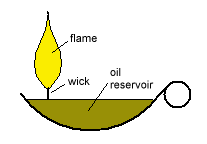 A self-feeding fire may be explained with a simple oil lamp, which has a reservoir of oil, a wick, and a flame burning on the wick. Left to itself, the oil in the reservoir would gradually be consumed, and the flame would be extinguished when there was no oil left.
A self-feeding fire may be explained with a simple oil lamp, which has a reservoir of oil, a wick, and a flame burning on the wick. Left to itself, the oil in the reservoir would gradually be consumed, and the flame would be extinguished when there was no oil left.
In some ways, an oil lamp is already a self-feeding flame, because the flame serves to draw up and vaporize the oil beneath it, and raise its temperature to the point of ignition. And this oil, once ignited, will in turn heat and vaporize more oil.
But with a slight variation, the oil lamp flame can be used to power a motor which pumps oil into the reservoir, and keeps it topped up. In this case, the energy of the flame is being harnessed to perform work, pumping oil along a pipe from elsewhere into its reservoir.
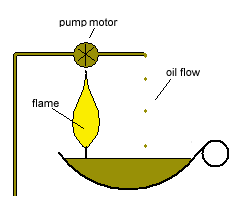 So long as the motor is able to keep pumping at least the same amount of oil into the reservoir as the flame is consuming, the oil reservoir level will stay constant. If the flame-powered motor pumps more oil than is needed, the reservoir will fill and overflow, but the lamp will keep burning. And if the motor pumps less oil than the flame consumes, the reservoir level would fall, and the lamp would eventually go out, and the oil lamp would 'die'.
So long as the motor is able to keep pumping at least the same amount of oil into the reservoir as the flame is consuming, the oil reservoir level will stay constant. If the flame-powered motor pumps more oil than is needed, the reservoir will fill and overflow, but the lamp will keep burning. And if the motor pumps less oil than the flame consumes, the reservoir level would fall, and the lamp would eventually go out, and the oil lamp would 'die'.
If the flame-powered motor pumps too little oil, the lamp is under-maintaining itself, and not pumping enough oil into the reservoir. If the motor pumps too much oil, the lamp over-maintains itself, and pumps too much oil into the reservoir.
If too little oil gets pumped into the oil reservoir by the flame-powered pump motor, the reservoir will gradually empty, and when it is empty the flame will go out. Death comes when the flame goes out. The oil lamp grows cold.
When too much oil gets pumped into the oil reservoir, it eventually overflows. In this case the flame-powered pump is doing more work than is necessary to top up the oil reservoir. But it doesn't have to work all the time. It can work part-time, doing just enough work to keep the reservoir topped up. It can do this moving the flame away from the pump, or by turning down the flame. The 'idleness' of the pump/flame is a measure of the fraction of the time it isn't working to pump oil. This can range from 0% to 100%.
|
Mathematical Excursion No. 1
If the oil consumption of the the reduced flame is Pm, and the increased oil consumption at full flame strength is Pe, and the rate at which oil is pumped is Pi, then oil lamp cell idleness I is given by I = 1 - ( Pm / (Pi - Pe)) And where Pi = 100 cc/h, and Pe = 10 cc/h. and Pm = 10 cc/h I = 1 - 1/ (100 - 10) = 88.9% |
An oil lamp that only works part-time refuelling itself is likely to keep burning longer than one which works full time refuelling itself - much like a forest fire burns itself out quickly, but a smouldering fire may burn for months or years, because they eat through available fuel sources more quickly or slowly.
The oil lamp may not just be refueling itself with oil, but also with oxygen with which to burn that oil, and whatever is needed to repair and renew every part of the oil lamp. The oil that it pumps into itself may be a mixture of things, which include the materials needed to repair the reservoir, the wick, the pump, and everything else in the lamp.
Oil Lamp Cell
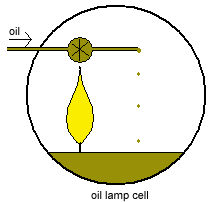 A living cell might be thought of as being a self-contained little oil lamp, inside its own protective bubble, working to pump oil into itself. to keep its tiny flame alight. The principal difference is that, rather than oil, cellular lamps burn sugars - such as glucose - which they capture from their environment, and they 'burn' them at very low temperatures. But the combustion products are the same: carbon dioxide and water. And they operate at a degree of idleness somewhere between 0% and 100%. Living cells either have to work very hard to survive (0% idleness) or they hardly have to work at all (->100% idleness). And if, even working flat out continuously, they can't maintain themselves, they die.
A living cell might be thought of as being a self-contained little oil lamp, inside its own protective bubble, working to pump oil into itself. to keep its tiny flame alight. The principal difference is that, rather than oil, cellular lamps burn sugars - such as glucose - which they capture from their environment, and they 'burn' them at very low temperatures. But the combustion products are the same: carbon dioxide and water. And they operate at a degree of idleness somewhere between 0% and 100%. Living cells either have to work very hard to survive (0% idleness) or they hardly have to work at all (->100% idleness). And if, even working flat out continuously, they can't maintain themselves, they die.
An oil lamp burning inside a spherical container would be protected from the outside elements. The flame would not be blown out by wind, or doused by water. The external membrane would therefore act to keep the flame alight, in concert with the oil burning in that flame. And because this external shell would be continually being eroded and damaged by the external environment, it would need to be replaced just like the burned oil would need replacing.
And while a large bright flame may only burn in an oxygen-rich gaseous atmosphere, a small glowing ember may continue to burn deep inside a cell if that tiny flame were kept fed with drops of oil and atoms of oxygen, fed to it like logs onto a fire in the hearth within a house.
Such cells would pump oil and oxygen and other materials into themselves, repairing and renewing themslves. As before, some would undermaintain themselves, and others would overmaintain themselves. Cells that over-maintain themselves may be thought of as swelling up with oils or sugars, and multiplying their number of pumps and wicks and flames. Cells that under-maintain themselves may be thought of as shrinking, and disposing of pumps and pipes and wicks and flames. For inside each cell there is also a little factory which makes pipes and pumps and wicks. And these component parts can also be chopped up and burned like so much wooden furniture.
And when these cells make new component parts of cells, they do so using a set of instructions which the cell keeps. It has lots of lists of instructions about how to make pipes and motors and wicks and all sorts of other things. And this is the genetic DNA component of the cell.
Oil Lamp Cell Growth and Division
In Idle Theory, reproduction is a consequence of cells slightly over-maintaining themselves, and acquiring fuel and other raw materials faster than they consume them.
In an equilibrium life process, exactly as much energy is acquired as is expended, and the amount of energy stored remains constant. But in practice living things are never in equilibrium. They are either gaining energy, and growing in size. Or they are losing energy, and shrinking in size. They are either over-maintaining themselves or undermaintaining themselves.
Now, if it supposed that there exists a population of living things, some of which are inherently disposed to slightly overmaintain themselves, and some which are inherently disposed to undermaintain themselves, then those which undermaintain themselves will gradually dwindle away and vanish, and those which overmaintain themselves will grow steadily larger and larger. After a while, the population will consist of living things which are genetically disposed to either precisely maintain themselves, or to over-maintain themselves. So populations of cells will always consist mostly of growing, enlarging cells, swelling up like drops of water.
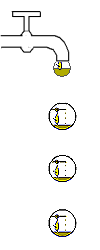 And when something like a living cell over-maintains itself, and grows in size, it will eventually divide in two. The reasons for this division are almost entirely mechanical in nature. And the process may be observed in a dripping tap, whereby a drip of water slowly grows until, at a certain size, its own weight exceeds the tensile forces holding it together, and it tears apart, releasing a single drop to fall, while the remainder of the the drip remains adhered to the tap, and begins in turn to gradually expand and swell as it is fed by a constant tiny stream of water. In this manner, the water running from a tap does not form an ever-largening drip, as big as a football. Nor does it produce a steady thin stream. Instead it grows to more or less constant size, and then divides into two drops of water. The result is a steady succession of drips. And this is cell reproduction. Cells are mostly composed of water, and are in effect drops of water clothed with a membrane skin.
And when something like a living cell over-maintains itself, and grows in size, it will eventually divide in two. The reasons for this division are almost entirely mechanical in nature. And the process may be observed in a dripping tap, whereby a drip of water slowly grows until, at a certain size, its own weight exceeds the tensile forces holding it together, and it tears apart, releasing a single drop to fall, while the remainder of the the drip remains adhered to the tap, and begins in turn to gradually expand and swell as it is fed by a constant tiny stream of water. In this manner, the water running from a tap does not form an ever-largening drip, as big as a football. Nor does it produce a steady thin stream. Instead it grows to more or less constant size, and then divides into two drops of water. The result is a steady succession of drips. And this is cell reproduction. Cells are mostly composed of water, and are in effect drops of water clothed with a membrane skin.
This division of expanding drops of water into separate droplets underlies Idle Theory's explanation of cell division. It's something that just happens when cells get past a certain size. And when they divide, the numerous organelles inside the cells (the pumps and pipes and wicks) are divided equally, or almost equally, between the two daughter cells, so that the daughter cells are equipped with the same inventory of component parts. Should it so happen, as it periodically will, that a cell will lack some key components, then the likelihood will be that the cell will die, or if it does not die, it will fail to reproduce. Or else, if there is a slight deficit of one or other component, it will be able to attain the correct balance fairly rapidly as new components are made within the cell.
So cell division or cell reproduction is simply a physical consequence of cell growth.
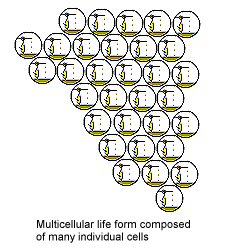 Unicellular life is made up of autonomous individual cells which live completely independent lives. But very often cells unite to form communities of cells. And in these communities of cells, different cells may be assigned different tasks. In these multicellular life forms, the cells continue to grow and divide.
Unicellular life is made up of autonomous individual cells which live completely independent lives. But very often cells unite to form communities of cells. And in these communities of cells, different cells may be assigned different tasks. In these multicellular life forms, the cells continue to grow and divide.
When these dividing and multiplying cells form the body of a multicellular organism, like an insect or a cat or a human, instead of that organism just getting bigger and bigger, it also tends to behave much like a dripping tap, and to form a daughter multicellular which will, in due course, separate from the parent. Sometimes this will happen when a multicellular organism breaks apart. More often it happens when a daughter multicellular grows up inside the parent, and then separates from it.
The whole of this process, of cell growth and division, and of multicellular growth and division, is one that is driven by the propensity of cells to overmaintain themselves.
Oil Lamp Cell Ageing
Why do multicellular living things, which are made up of countless reproducing cells, not keep on just growing bigger and bigger? Why do they invariably grow to roughly the same size, and stop growing? And then even start to shrink?
The rate at which cells reproduce is determined by how much they over-maintain themselves. If a cell is seen as a house whose owner buys in more bricks and tiles and glass and wood than is actually needed to keep it in good repair, he will eventually have enough of these materials to build a complete new house. And cells do this. And this is why they grow and divide.
But there is no reason why all cells should over-maintain themselves equally, and reproduce at the same rate. Some cells might over-maintain themselves a lot, and reproduce rapidly, and some cells may over-maintain themselves only a little, and reproduce slowly.
And it may be supposed that, whenever a cell divides in two, the two daughter cells don't reproduce at the same rate as each other, or at the same rate as the parent cell. It may be that, whenever a cell divides, one daughter is always a fast reproducer, and the other a slow reproducer, such that the sum of their reproductive rates is that of the parent cell. This might happen because one daughter might have more of the parental factory production equipment than the other.
And so, in the body of a multicellular living thing there will be some cells that are reproducing rapidly, and some slowly.
It might be supposed that fast-reproducing cells will come to outnumber slow-reproducing cells. But fast-reproducing cells are less idle than slow-reproducing cells, because they perform more work. And because they are less idle, they are nearer the zero-idleness threshold of death.
The fastest reproducing cells are ones which work continuously over-maintaining themselves, and have zero idleness. Cells of this sort are reproducing as fast as they possibly can, but their chances of survival are zero. Any change for the worse in the the environment in which they live will render it impossible for them to survive.
The internal environment of any body mass of cells is likely to be fairly uniform in temperature and fuel abundance and other factors. But the entire environment will never remain at any stable equlibrium. The temperature and fuel abundance will rise and fall. Cell idleness within this body climate will always be varying through its changing seasons. And there will be differential cell survival within that body, as some cells' idleness falls to zero.
Slow-reproducing cells are more idle than fast-reproducing cells, because they perform less work, and will be able to survive where busy, fast-reproducing cells cannot. Busy fast-reproducing cells may tend to quickly outnumber slow-reproducing cells, but they live briefer lives. And so, instead of a body mass of cells being made up of fast-reproducing cells, it will instead tend to be made up of ever more slow-reproducing cells. There will be a natural selection of cells in favour of the idlest, slow-reproducing cells.
And as a body of cells is made up of ever more slow-reproducing cells, it will tend to grow more and more slowly. Eventually, it will be composed of cells which hardly reproduce at all. There may even be cells that under-maintain themselves rather than over-maintain themselves, and which gradually dwindle away and die.
This is the Idle Theory of ageing. Deep within any multicellular body of reproducing cells, the idlest and slowest-reproducing cells will gradually tend to predominate. Multicellular organisms will tend to start with busy, fast-reproducing cells which leave ever more idle and ever more slow-reproducing descendants. Living things that are made up of such cells will tend to grow to a maximum size, and then start to shrink. The little boy grows rapidly to become a big, strong man, who then gradually dwindles away to become a little old man.
And this will be the fate of most of the reproducing cells within a large multicellular organism like a cat or a man. The cells will gradually reproduce more and mmore slowly, leaving only the idlest, slow-reproducing cells. But it will not be true of cells on the external surfaces of such multicellular organisms. Cells at the surface will not enjoy a uniformly warm, protected environment. They will be subjected to impacts, to extremes of heat, to chemical erosion, and to predator attack. The cells at the surface of a multicellular will live like soldiers in a front line battlefield, in a field of bullets, in which any of them are as equally likely to be struck down as any other. In this front line, the slight advantage in idleness that slow-reproducing cells enjoy in the uniform 'civilian' interior completely vanishes. They are equally likely to die as fast-reproducing cells. And in this circumstance, fast-reproducing cells tend to predominate. So the populations of cells at the perimeter of multicellular organisms will be made of ever more fast-reproducing cells.
And so it may be that the ridged and furrowed skins of elderly people are made up of ever-more-fast-reproducing cells whose populations form a skin surface that is ever looser, more folded and furrowed.
|
Mathematical Excursion No. 2
Where Pr is the expenditure by a cell of energy/oil on growth, cell idleness I is given by I = 1 - ( (Pm + Pr) / (Pi - Pe) ) Pr is greater in fast-reproducing cells than slow-reproducing cells, and so idleness I is lower in fast-reproducing cells than slow-reproducing cells. In the uniform but varying internal environment of multicellular organisms, a changing environment affects all cells in the same way, and idleness rises and falls in concert. And the least idle cells die out.
In a reproducing population of cells, if the work required to produce a new cell is Ec, and the rate at which this work is done is Pr, then a population of N cells will increase at a rate N. Pr / Ec If an accidental death rate D is imposed on all cells regardless of their idleness then the population of cells will increase at the rate N.( Pr/Ec - D ) For cells at the multicellular exterior, D will be large. For protected internal cells D will be small. Internal cells growth work rate Pr will fall until N.( Pr/Ec - D ) = 0 and busiest, fast-reproducing cells die out. On external surfaces, cell death rate D will exceed reproduction rate Pr/Ec when Pr is small, and slow-reproducing cells will die out. |
A similar explanation might also be given for how cells come to specialise in one or other activity. For example, in a population of cells that are subjected to compressive forces as a multicellular organism grows, those daughter cells which have greater compressive strength will tend to survive where others with less compressive strength do not. Bones may simply be made up of reproducing cells which have been naturally selected for compressive strength. And the cells in tendons may simply be made up of cells that have been selected for tensile strength. And the same will apply to every other cell in the body. It may not be any sort of plan, locked in the DNA of genes, which determines the overall structure of a body of cells, and its differentiation into separate specialities, but instead a process of natural selection within the internal environment of a mass of reproducing cells.
If all the rivers of the world are alike, and are fed by tributary streams and rivulets, which merge into one mighty river that flows out into the ocean, it is not because rivers are born with river 'plans' built into them, but because they follow the logic of water, and this always results in structures that are recognisably rivers. In the same way, there may be no overall master plan that determines whether one population of reproducing cells becomes a turtle or a peacock or a man, but instead a cellular logic which always ends up producing turtles and peacocks just like falling water always produces lakes and rivers. And so it may be that any attempt to find a detailed master plan, of how to build a human being, encrypted into the DNA of human genes, will always prove fruitless, because there is no master plan. There is instead a logic of cells whcih is as inexorable as the logic of gravity or motion. It may be that DNA carries within it instructions for how to build simple proteins, and nothing else whatsoever.
A body of cells may also be thought of as a trading system, in which different tools and materials are manufactured and traded. In this economy, each cell is part of some factory which performs specialised work in exactly the same way that human econmies have specialised factories and offices and roads. But instead of trying to do as much work as possible, and be as busy as possible, the bodily economy tries to do as little as possible, and achieve a maximal idleness. These cell collectives may form political societies, in which overall command of the collective is placed in the hands of idle brain cells, while other cells busy themselves synthesizing materials, or disposing of wastes, or working muscles. It is a political society in which all members have a veto in the form of shouts of pain, and in which there might be revolts and coups, just like in human political society. Such societies of cells were not ones which were carefully planned in advance. They were the product of millions of years of evolution. They were what survived after countless variants had been tried and disposed of.
One last question. If most of the cells in multicellular organisms gradually reproduce more slowly, how to mature adults made up of slow-reproducing cells give birth to fast-growing offspring with fast-reproducing cells. Or, same question, why don't species age and die in the way that their individual members age and die? The answer may be that sexual reproduction unites fast-reproducing cells with slow-reproducing cells to produce cells with an intermediate reproduction rate. The slow or non-reproducing cells are the female eggs which are found deep in the interior of a multicellular. The fast-reproducing cells are the male sperm cells which are found in the external testes. If it takes many years before a multicellular organism reaches sexual maturity, it may because it takes time for egg cell reproduction to slow to a stop, and for sperm cell reproduction to speed up to a maximum. The union of the two then 'resets' the combined cell reproduction rate to a value fixed halfway between.
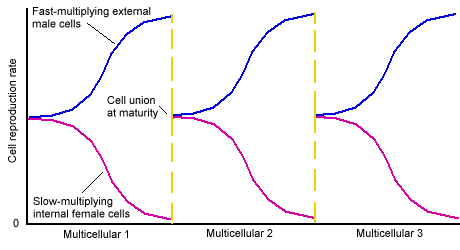
But this final speculation has probably driven the oil lamp analogy of life too far.
The Ever-burning Oil Lamp of Life
Idle Theory's notion of life as a self-sustaining combustion process suggests that life is not something at all unusual. In its view, life can start up wherever there is any sort combustion process, whereby two chemical compounds can combine to produce heat. There are an almost infinite number of such combustion processes. All that is needed to produce a primitive form of life is for that heat to act to feed the combustion process.
Something as simple as a forest fire is, in Idle Theory's terms, a form of life. Burning trees act to heat up adjacent trees, and set them ablaze, and thereby feed the fire. The fire grows, and it may also multiply, spawning daughter blazes. But a forest fire is not a very efficient form of life. Forest fires expend huge amounts of energy, and last only a few days.
Smouldering fires, by comparison, will eat through their fuel sources much more slowly, and last far longer. And the fires that smoulder in plants and animals burn still cooler, and last far longer. In fact, theirs is a fire that has never stopped burning for over 500 million years, and feeds upon sunlight. For it is the energy of the sun which powers all plant life, and all those animals that feed on plants. In the remote past, it may well have been the life was powered by other fuel sources, most of which have now been exhausted. More or less the sole survivors have been those forms of life which had mastered the art of tapping the radiant energy of the sun. The history of life has been the history of the evolution of fire, burning ever cooler, and fueled by an ever-changing set of energy sources. What we think of as life - DNA-based life - is most likely a very late stage in that evolutionary process. There is probably zero probability that life of this sort would appear in one bound upon an otherwise lifeless planet. Or no more likely than a barren and lifeless planet might suddenly produce a population of beautiful blue and green birds.
Life of this sort is also not trying to do anything. The flame of life is just passed on from one generation of fires to the next. The fires that keep burning the longest are the ones most likely to spawn daughter fires. All of life's innovations have just been ways that so happened to keep the fire burning. Some of them were more efficient than others, and they were the ones which tended to survive and reproduce.
In time, as self-feeding fire evolved, those fires that could actively seek out and capture fuel would sometimes outlive those that just sat and waited. The tiger that consumes a deer is one bonfire that captures and consumes another. It is a fire that runs on legs, and grasps with claws. It just so happens that those kinds of fire that we call tigers are ones which have survived and reproduced. Life is not trying to stay alive any more than a garden bonfire or a burning match tries to stay alight. Some fires keep burning, and some don't. A ferocious propensity to capture and consume other animals is not an attribute that helps our small modern tigers half as much as a warm purr and a friendly miaow. Our modern tigers sit and wait to be fed. And they are very successful.
Related essays:

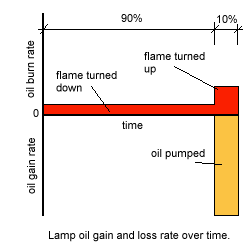 Where a lamp overmaintains itself by continuously pumping oil into its reservoir, it can be arranged to more or less exactly maintain itself by switching its pump on and off to regulate the flow. So for example if the flame burns 10 cc of oil per hour, and the motor can pump 100 cc of oil per hour, the motor need only be working one tenth of the time to keep the flame burning, and the motor will spend 90% of its time idle. Or the same result (see right) would be achieved if the flame was reduced to a minimum for 90% of the time, and turned back up to full strength for the other 10% of the time to drive the pump motor. So an oil lamp with a powerful pump like this would be 90% idle. And an oil lamp with a pump that could only pump 10 cc of oil per hour would be working continuously to maintain itself, and would be 0% idle.
Where a lamp overmaintains itself by continuously pumping oil into its reservoir, it can be arranged to more or less exactly maintain itself by switching its pump on and off to regulate the flow. So for example if the flame burns 10 cc of oil per hour, and the motor can pump 100 cc of oil per hour, the motor need only be working one tenth of the time to keep the flame burning, and the motor will spend 90% of its time idle. Or the same result (see right) would be achieved if the flame was reduced to a minimum for 90% of the time, and turned back up to full strength for the other 10% of the time to drive the pump motor. So an oil lamp with a powerful pump like this would be 90% idle. And an oil lamp with a pump that could only pump 10 cc of oil per hour would be working continuously to maintain itself, and would be 0% idle.
